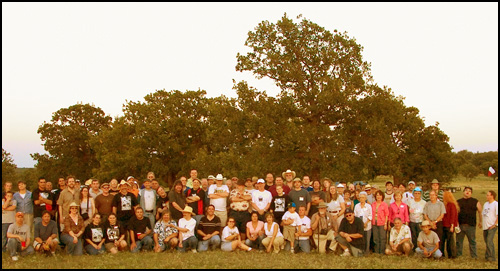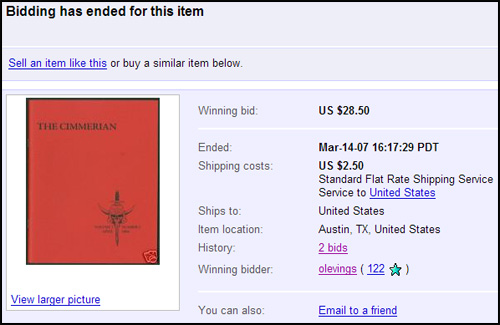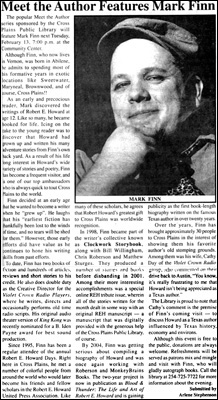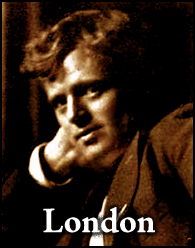REHupa Mailings Holding Their Own
Friday, March 23, 2007
posted by Leo Grin
After releasing The Complete REHupa in August of 2006, I wondered if that digital archive would reduce the value of the paper mailings. Don Herron assured me it wouldn’t. “True collectors need the paper,” he said. I knew that logically he was right, that there is something special and tactile about holding a mailing in your hand, perusing the different styles of paper, appreciating the full-color zines. None of that translates to a B&W digital format designed for quick ‘n’ dirty reading and printing.
But how many of the collectors out there have been scooping up mailings solely to read the contents, and how many to have them joining their first editions and other miscellany in their collections? If there are far more of the former, would that lower the average selling price of the mailings as The Complete REHupa made its inexorable spread throughout the REH fandom sphere?
In a way it was a moot point to me, as I am determined to get rid of my old mailings regardless. I’m the kind of guy who, with very few exceptions, is as happy with an e-text as I am with a real book. I just want the words — the magic is created in my mind, not in the quality of paper or the art of a published book. There are exceptions to this, and occasionally a book I really like speaks to me in such a way that I want to have it on the shelf. But I can’t stand clutter and vast areas of my living space taken up with books I seldom read, and I am about as far away from the packrat mentality as can be.
So now that The Complete REHupa is finished through mailing #199, the large stack of mailings I accumulated in my research has to go. Far better to find them a home where they will be cherished and well cared-for. As I prepared to offer them on eBay, I mused whether they might now go for a much lower price than they went for as recently as early last year, when $50-$100 was the average for the mailings I sold. A couple years ago the average price was $20 per, but as of last spring that price point was way out of date. Clearly a jump had occurred due to increased interest in Howard and increased education among collectors about the essential value of these mailings. Heading into 2007, would all of that hold? Or would we see prices slipping back into the old range?
Last week I put the first two of many mailings up for auction, and the results are in:
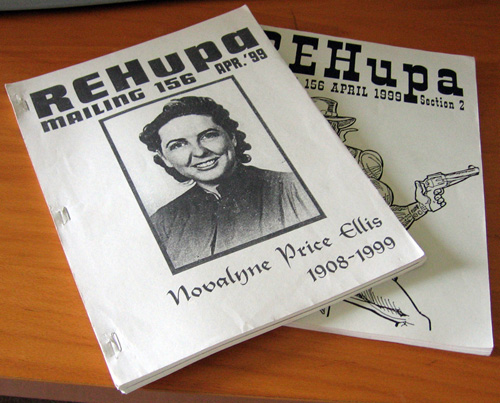
REHupa #156 (April 1999) is an important mailing both due to its coverage of the death of Novalyne Price, and to the inclusion of Pictures in the Fire, a great booklet detailing all of the known photos of REH at that time along with all of their published appearances. That’s not to mention the usual plethora of other items included in the typical mailing. This one sold on eBay for $46.75, which many behind-the-times fans consider excessive but which I consider a steal. I anticipate special mailings like this going steadily up-up-up in value as time goes on.
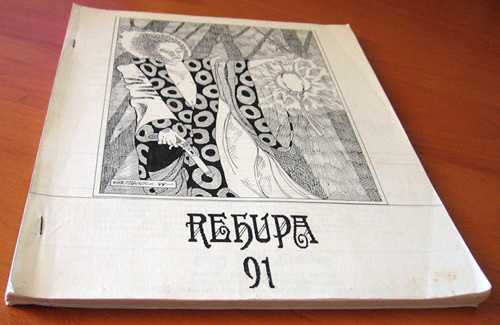
REHupa #91 (May 1988) is the infamous “lost mailing” of REHupa, formed out of ‘zines culled from the four winds of the a.p.a. after the Official Editor vanished with all the a.p.a.’s assets: mailings, treasury, even the stapler. It didn’t get mailed until a year after the event, and then only to those who were members at the time the crisis occurred. As such it is a truly rare mailing with a particularly small universe of extant copies. After some furious bidding the auction ended with this one selling for $158.52, which some people gasp at but which I think is a fair, even cheap price. I’ve seen far less go for far more on eBay, and this is a true Howard collectable that one is not likely to see for sale very often. When at least two people are ready to shell out $150 for it, that says something.
So it looks as if Don’s oft-stated claim of being “right 95% of the time” still stands, and the savvy collectors out there are indeed still enamored with paper. I’ll be unloading the rest of my REHupas in the coming weeks, and will be interested to see what some of the more recent mailings go for. A copy of #185 just went for $15.50 on eBay, a real steal for the lucky guy who snagged it. It won’t be long before that one feels as old and rare as #91 and #156, with the prices creeping up accordingly. I can’t say it enough: all of these collectors beaming with pride over their copies of the Arkham House Skull-Face and Others and their copies of the Cryptic chapbooks aren’t even in the running anymore. The real giants of the field are on to much rarer game: the Jenkins Gent from Bear Creek of course (another book which I, a non-collector, have owned at one time), but also “almost-but-not-quite impossible” feats like a complete collection of REHupas, which when taken together contain many first edition appearances of original REH and serve as a running history of Howard fandom and publishing for the last thirty-five years.
My sense is that right now there is a reshuffling going on in the Howard collecting sphere, with mailings being passed around to a new group of people eager to get them. Once these errant mailings are all safely tucked away in various hoards, they will become really scarce on the open market for a long while, until those collectors start dying off. In addition, Howard is being reseeded into the popular culture with movies, comics, and books. A second boom is clearly underway, at least in our little niche world, and if one or more films are successful then the Boom can spread worldwide, with many more people than ever before becoming interested in Howard. Once that happens, $200 for one of those mailings will seem dirt cheap. That’s my call, anyway. We’ll see what happens.

